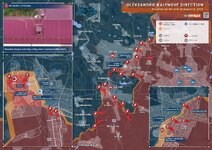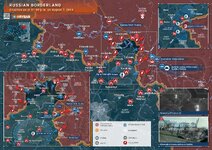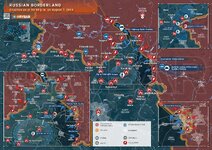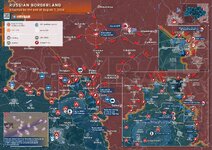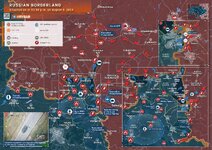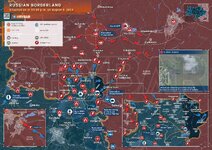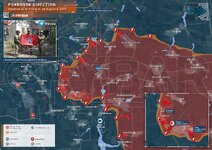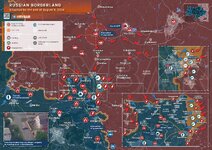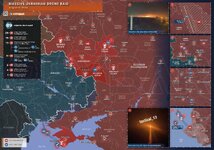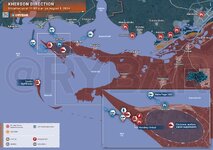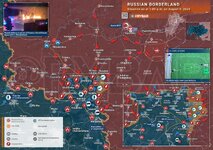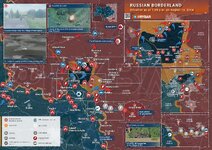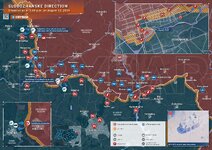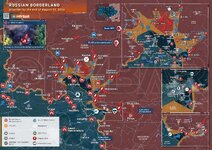Great explanation of the tactics used by the Russians in Kursk right now:
Full text:
AW:
The only thing I'd want to add to Mikael's excellent analysis here is that the Russians are actually fighting a much more conventional area defense than we've seen in the very static fighting in the Donbass.

They're not trying to stop Ukrainian drives at the screen line like we saw in the Hundred Days, they're instead diverting them into engagement areas between their front line of screening troops and the main defensive line 5-10km to the rear and destroying them there. Ergo why we've seen Ukrainian units just go on these long runs in the last couple days - way past where the front line should be - and then get wiped out in what look like complex ambushes. That's... actually just how you do a very normal area defense.
Why have the Russians changed tactics? Two reasons. First, in Kursk they - paradoxically - have space to fight. The Donbass is a cramped theater where real estate is at an absolute premium. They're either backing up into the sea, key lines of communication, or critical urban areas there. There's actual operational space in rural Kursk.* Second and relatedly, the "forward" defense we're used to seeing in the Donbass will not inflict crippling casualties on an attacker quickly for the simple reason that attacks often fail in the "cone of fire" in no man's land or even behind the attacker's front line, allowing defeated units to easily withdraw. In a conventional defense the attacker is defeated in a kill zone behind the screen line and it is far easier to annihilate an attacking force. Ergo why we're now seeing huge AFU equipment losses, with entire Ukrainian companies burning out behind the ostensible Russian "front."
Having found themselves in battle with the AFU's strategic reserves, the Russians now very much intend to use the Battle of Sudzha-Korenevo to destroy as much of those reserves as possible. Even if that means scaring some war mappers on the internet.
* I remind the reader that, de jure, there's no difference between Kursk (or any other part of pre-2014 Russia) and the Novorossiyan oblasts in the eyes of the Russian government right now.
(shown - exactly such an engagement earlier today with an attacking Ukrainian unit south of Sudzha)
MV:
ANALYSIS: MAPPING IN FOG OF WAR, AUG 12th 2024
It's much harder to be sure of frontlines during maneuver warfare and directly after a breakthrough, than during static attritional warfare. At the Kursk front we see it daily. I'll try to explain how to be as sure as possible. A disclaimer, the maps and signs on them are only approximate examples.
Normally we have an established frontline and changes are reported from both sides. If the side that loses territory admits it, it's often seen as the truth, because nobody usually admits defeat without cause. If the attacker claims territory you usually want some kind of corroborated evidence as a geolocated video or photo.
It is different when the warfare is fluid during maneuver warfare. First of all you can't rely on either side to give correct information. If neither side is very superior to the other side, as in the Russo-Ukrainian war, breakthroughs will be blocked after a while and the frontline will be stabilised again.
An attacker wants both to reach as far as possible and secure captured territory as much as possible. You do this by utilising both offensive and defensive troops. The offensive units thrust as deep as possible into enemy territory and create havoc behind enemy lines.
Defensive units move slowly and fortify secured territory.
When the defender reacts much of the territory filled with the attackers forward units probably will be reclaimed by the defender. This stimulates both sides to give reports of the war that make them look good in the long term.
The attacker doesn't want to claim too much initially, since they might lose much of the forward area later on. If this happens, it will seem like the defender conducts a successful counteroffensive, retaking much territory.
The defender on the other hand might initially exaggerate the attackers reach, so they can claim a quick retaking of territory. In Kursk the usually reliable Ukrainian Deepstate UA has claimed very little territory controlled by UkrAF. Russian Rybar on the other hand admits much larger losses of territory than most neutral mappers claim.
If we look on map 1, the blue is an example of admitted secured Ukrainian territory. The purple is an approximation of how far Ukrainian forward units reached. Many Russians were fast to admit this as Ukrainian gains. The new stabilised frontline will probably be established closer to the yellow line, near initial Ukrainian claims.
This makes it hard to rely on either side for good information during the initial period. The main remaining source to rely on are geolocations. But this will also take some time until you get enough information to draw a good picture, or map.
Initially such a map might show fantastic advances by the attackers. There will be geolocations in a large area of attacking/Ukrainian units (blue X on map 2) or Russian attacks on such Ukrainian units (red dots). This gives the impression of Ukrainian control everywhere, but in reality it only shows that there are Ukrainian units there.
Closer to the border Ukrainian control is more reliable. We also see some places with geolocated Russian presence. Then we know that those places are not in Ukrainian hands. Later on we get more and more geolocations. The more Russian units geolocated, either by showing their presence (red X on map 3) or being attacked by UkrAF (blue dots) makes it easier and easier to finally see a new frontline.
The same is of course true for Ukrainian units, but the other way around. If they disappear from part of the map, we can be pretty sure that they have left that territory.
A big question mark right now is the yellow area in the North. Russian units are south of it, but many Russian videos of attacks on Ukrainian units in this area have been seen. In the western part Ukrainian units seem to have disappeared, but in the NE Ukrainian units still remain. Those are currently probably not an attacking spearhead as some claim, but remains of a former spearhead.
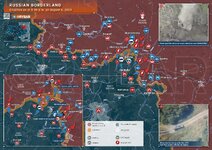
 The situation in the Kursk region remains tense: at the moment, the main battles are still taking place in the Sudzha and Korenevo districts, where, judging by the latest footage, the Armed Forces of Ukraine have managed to advance.
The situation in the Kursk region remains tense: at the moment, the main battles are still taking place in the Sudzha and Korenevo districts, where, judging by the latest footage, the Armed Forces of Ukraine have managed to advance. Moving from the Sverdlikovo direction, units of the Armed Forces of Ukraine in Stryker armored personnel carriers were able to reach the Rylsk-Sudzha highway, along which they attempted to advance in the direction of the village of Zeleny Shlyakh. However, on the section of the highway to the east of the village of Nizhnii Klin, the enemy armored group was ambushed, and the equipment itself was later finished off by Russian drones.
Moving from the Sverdlikovo direction, units of the Armed Forces of Ukraine in Stryker armored personnel carriers were able to reach the Rylsk-Sudzha highway, along which they attempted to advance in the direction of the village of Zeleny Shlyakh. However, on the section of the highway to the east of the village of Nizhnii Klin, the enemy armored group was ambushed, and the equipment itself was later finished off by Russian drones. At the same time, clashes continue on the section of the 38K-004 highway near the Sudzha checkpoint, as well as in the area of the village of Gordeyevka. However, due to the lack of objective footage, it is difficult to establish the exact configuration of the front in these areas.
At the same time, clashes continue on the section of the 38K-004 highway near the Sudzha checkpoint, as well as in the area of the village of Gordeyevka. However, due to the lack of objective footage, it is difficult to establish the exact configuration of the front in these areas. Ukrainian media are actively distributing videos of captured Russian servicemen in the area of the Hlyboke Tract, from where Ukrainian troops had tried to advance towards Kurilovka. Also, a photo of a burnt Russian Ka-52 helicopter appeared on the Internet.
Ukrainian media are actively distributing videos of captured Russian servicemen in the area of the Hlyboke Tract, from where Ukrainian troops had tried to advance towards Kurilovka. Also, a photo of a burnt Russian Ka-52 helicopter appeared on the Internet. The Armed Forces of Ukraine continue to strike with artillery and drones throughout the Kursk region. According to the latest data, three people were killed in the region, at least 18 were injured, including children.
The Armed Forces of Ukraine continue to strike with artillery and drones throughout the Kursk region. According to the latest data, three people were killed in the region, at least 18 were injured, including children. Russian troops are also firing at enemy positions and concentrations - one of the strikes hit a Ukrainian Buk-M1 air defense system, which was destroyed by a missile strike north of the village of Senne in the Sumy region.
Russian troops are also firing at enemy positions and concentrations - one of the strikes hit a Ukrainian Buk-M1 air defense system, which was destroyed by a missile strike north of the village of Senne in the Sumy region. From a media point of view, the enemy received the necessary footage of both: captured Russian servicemen and the advancement of an armored group up to 6 km from the border - even if the evidence is footage of their own destroyed armored personnel carriers. However, this will be more than enough to interrupt negative informations, such as the loss of control over New York.
From a media point of view, the enemy received the necessary footage of both: captured Russian servicemen and the advancement of an armored group up to 6 km from the border - even if the evidence is footage of their own destroyed armored personnel carriers. However, this will be more than enough to interrupt negative informations, such as the loss of control over New York. It is not worth to expect a quick end to the attacks: fierce battles will continue in the Kursk region, and it is also impossible to rule out the activation of enemy troops in other areas. Moreover, the enemy’s actions reveal a plan of an offensive in the most “thin” places with the aim of forcing the RF Armed Forces to transfer forces from other directions."
It is not worth to expect a quick end to the attacks: fierce battles will continue in the Kursk region, and it is also impossible to rule out the activation of enemy troops in other areas. Moreover, the enemy’s actions reveal a plan of an offensive in the most “thin” places with the aim of forcing the RF Armed Forces to transfer forces from other directions."

